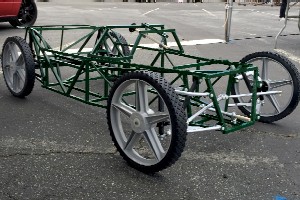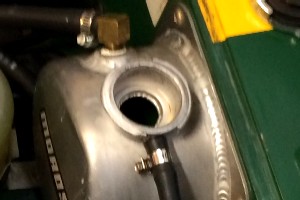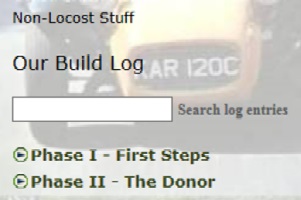 |
||||||
|
views:
May 18, 2016 The Bay Area Maker Faire is now only days away and we've done just about all we can to get the Locost ready, i.e. basically nothing. We do plan to wash and wax the car before we go, and we'll bring along some cleaning supplies in case we get motivated to do more, which is unlikely but you never know. A bigger priority right now is putting together our giant display board, with pictures and accounts of the build, which helps to keep people at the Faire from asking questions, but doesn't stop them altogether because apparently not everyone can read. Or wants to.
In the meantime our other project, the wooden mock-up of our little Locost, is all painted and ready to go. We found some really cheap plastic wheels online to hold it up, and the half-scale car should make a nice addition to the exhibit, so long as we can figure out a way to transport it to the show. It might take more than one trip. If we disassemble it into its component parts, everything except the frame fits into a small box. The frame itself weighs only about eight ounces, but it's almost six feet long and doesn't fit into the Big Locost very easily. Or at all. In this week's cooling system report, we're happy to announce that we haven't had to add any coolant to the system in over a thousand miles. We do check the level regularly, and it's always about 1" down from the top of the tank, i.e. a good 2-3" above the top of the cylinder head. We don't bother to top it up, because a) the coolant level is always the same, and b) it probably needs that inch of space for expansion. We still haven't experienced any really hot days yet, but we're pretty confident that we finally have the cooling system we always wanted.
In the meantime we've been tweaking the calibration of our temperature gauge, which reads high based on our opinion that it should sit at N (normal), or slightly below N, in everyday driving, the way our Miata does. We of course know nothing about temperature gauges, so we didn't touch the device itself, but instead added a few ohms of resistance to the sender. We started with 10 ohms, which wasn't quite enough, so we thought maybe 15 ohms would do the job, but of course we didn't have any 15 ohm resistors, because that would've been too easy. We did have a decent selection of higher ohm resistors, so we played around with different combinations, starting with a 22-ohm and 33-ohm in parallel, which according to the Internet would resist 13.2 ohms, which it may have but it still wasn't enough. So next we tried three resistors, what looked like a 33 and two 100s, which would give us around 18 ohms. But this brought the temperature gauge way down, too far even for us, so we tried again, wiring together a pair of 33s for an even 16.5 ohms, which should've been about perfect but once again the needle crept past N.
Obviously we were doing something wrong, starting with the assumption that we knew how to read the little color bands on the resistors. Rather than fool around with the Internet any longer, we took a trip to our local Harbor Freight and picked up a $6 digital multimeter, the finest available. Oddly, the little device was surprisingly accurate, measuring our selection of 10, 22, and 33 ohm resistors to within 0.2 ohms, well within their 5% accuracy range. Even better, our makeshift 16.5 ohm resistor measured 16.5 ohms, and our 13.2 ohm pack measured 13.3. On the other hand, our supposed 18 ohm resistor pack measured 54 ohms, a finding that totally justified the $6 investment in the multimeter all by itself. This now gave us a range to work with. 16.5 ohms was not cool enough, and 54 ohms was too cool. So we plugged in a 22 ohm resistor, which turned out to be perfect, except when it wasn't, like for instance at stop lights when the gauge would creep toward the upper edge of the N. So we swapped the 22 ohm resistor for a 33, and now the needle hovers around the lower edge of the N, which is even more perfect.
So that was a lot of trial-and-error, and steely-eyed readers may notice that none of these changes actually did anything to lower the temperature of the cooling system, but that wasn't the point. As noted above, the cooling system works perfectly. Only the gauge was wrong. We like where it reads now, although we do feel a twinge of guilt over having tricked it with all of that extra resistance. I'm sure we'll get over it. At some point we might try adding another 100 or 200-ohm resistor to the 33 to bring it down a few ohms, but probably not. We finally added a search engine to our website. Not a real search engine. Those are expensive and/or time-consuming to build. Real search engines have a couple of complex and sophisticated components. The first runs all day long, collecting information from millions of sources around the world, and stuffing it into highly-indexed data files. The second gets a search string from a web page, like for example Google, parses it into something that makes sense to the search engine, and then retrieves likely matches from its collection of highly-indexed data files.
Our search engine does none of that. We only have one data source, or at least only one that we actually care about, so we don't have to collect anything. We also don't have to parse anything, or at least we're not willing to, because it's a big job that never ends. Google has dozens of developers working full time on their parsing algorithms, trying to make them better at figuring out what people are trying to ask. We can't do that. As we've noted here in earlier reports, our website has only one part time developer who doesn't do a lot, and certainly not algorithms. But as our website has grown it's gotten harder and harder for us to find something we might've written years ago, so we now have a search box above the log entries. You can enter a search word or phrase in the box and the web site will pull up a list of all the entries that have that exact word or phrase in the text. This may not be a lot of help with words like "Locost" or "the", which will pull up just about everything, but you may get lucky with more specific phrases like "roll bar" or "Aabaco sucks". Or maybe not. No guarantees. |
About Our Locost Please Note: Our database is currently unavailable so you will not be able to browse through log entries. This happens sometimes, and it usually doesn't last long. We're sorry for the incovenience. Please try again later. Or in a few minutes. | |||||
 Home
Home




